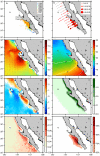The making of a productivity hotspot in the coastal ocean
- PMID: 22132156
- PMCID: PMC3221696
- DOI: 10.1371/journal.pone.0027874
The making of a productivity hotspot in the coastal ocean
Abstract
Background: Highly productive hotspots in the ocean often occur where complex physical forcing mechanisms lead to aggregation of primary and secondary producers. Understanding how hotspots persist, however, requires combining knowledge of the spatio-temporal linkages between geomorphology, physical forcing, and biological responses with the physiological requirements and movement of top predators.
Methodology/principal findings: Here we integrate remotely sensed oceanography, ship surveys, and satellite telemetry to show how local geomorphology interacts with physical forcing to create a region with locally enhanced upwelling and an adjacent upwelling shadow that promotes retentive circulation, enhanced year-round primary production, and prey aggregation. These conditions provide an area within the upwelling shadow where physiologically optimal water temperatures can be found adjacent to a region of enhanced prey availability, resulting in a foraging hotspot for loggerhead sea turtles (Caretta caretta) off the Baja California peninsula, Mexico.
Significance/conclusions: We have identified the set of conditions that lead to a persistent top predator hotspot, which increases our understanding of how highly migratory species exploit productive regions of the ocean. These results will aid in the development of spatially and environmentally explicit management strategies for marine species of conservation concern.
Conflict of interest statement
Figures


References
-
- Ware D, Thomson R. Bottom-up ecosystem trophic dynamics determine fish production in the Northeast Pacific. Science. 2005;308:1280–1284. - PubMed
-
- Sydeman W, Brodeur R, Grimes C, Bychkov A, Mckinnell S. Marine habitat “hotspots” and their use by migratory species and top predators in the North Pacific Ocean: Introduction. Deep-Sea Res. II. 2006;53:247–249.
-
- Croll D, Marinovic B, Benson S, Chavez F, Black N, et al. From wind to whales: trophic links in a coastal upwelling system. Mar Ecol Prog Ser. 2005;289:117–130.
-
- Guinet C, Dubroca L, Lea M, Goldsworthy S, Cherel Y, et al. Spatial distribution of foraging in female Antarctic fur seals Arctocephalus gazella in relation to oceanographic variables: a scale-dependent approach using geographic information systems. Mar Ecol Prog Ser: 219, 2001;251-264
-
- Etnoyer P, Canny D, Mate B, Morgan L, Ortega-Ortiz J, et al. Sea-surface temperature gradients across blue whale and sea turtle foraging trajectories off the Baja California Peninsula, Mexico. Deep-Sea Res. II. 2006;53:340–358.
Publication types
MeSH terms
LinkOut - more resources
Full Text Sources

